Abromination
Hazard to Others
  
Posts: 432
Registered: 10-7-2018
Location: Alaska
Member Is Offline
Mood: 1,4 tar
|
|
Kitchenware Pyrex on Hotplate
I recently acquired some pyrex branded home ware borosilicate (I am assuming) glass Tupperware containers and was wondering if I could safely put it
on my ceramic hotplate top. I know you can bake in them but wanted to check if it was safe for hotplate use. They work well as dishes and I needed a
wide one for a water bath.
Anyone else have experience with these?
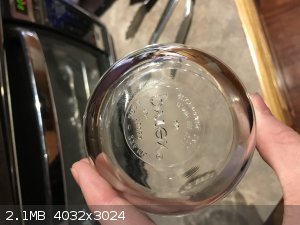
[Edited on 12-21-19 by Abromination]
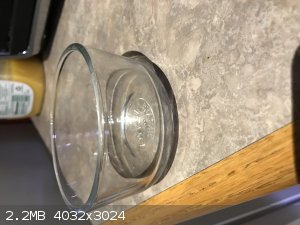
[Edited on 12-21-19 by Abromination]
List of materials made by ScienceMadness.org users:
https://docs.google.com/spreadsheets/d/1nmJ8uq-h4IkXPxD5svnT...
--------------------------------
Elements Collected: H, Li, B, C, N, O, Mg, Al, Si, P, S, Fe, Ni, Cu, Zn, Ag, I, Au, Pb, Bi, Am
Last Acquired: B
Next: Na
-------------- |
|
|
B(a)P
International Hazard
    
Posts: 1110
Registered: 29-9-2019
Member Is Offline
Mood: Festive
|
|
I have used them on low temps (<150C) for drying, no issues.
|
|
|
Sulaiman
International Hazard
    
Posts: 3555
Registered: 8-2-2015
Location: 3rd rock from the sun
Member Is Online
|
|
Notice that the brand is 'pyrex' which is toughened soda-lime glass,
'Pyrex' or 'PYREX' is borosilicate.
Whether toughened or borosilicate, a hotplate only touches the glass in a few places so thermal stress is unavoidable.
A metal pan with a thin layer of sand or salt evens out the heating.
CAUTION : Hobby Chemist, not Professional or even Amateur
|
|
|
Sigmatropic
Hazard to Others
  
Posts: 307
Registered: 29-1-2017
Member Is Offline
Mood: No Mood
|
|
Unless it says borosilicate on the glass, and I cannot read the picture because you photographed from the wrong side and everything is mirrorred, it's
heat resistant glass. I'd be very wary to use it on a hot plate and would only use it for water baths, no oil and certainly no reaction mixtures.
Air, sand or metal baths are what I prefer.
|
|
|
Amos
International Hazard
    
Posts: 1406
Registered: 25-3-2014
Location: Yes
Member Is Offline
Mood: No
|
|
I've used these containers quite successfully on ceramic hotplates that are slow to cool and heat but they ALWAYS shatter in contact with open flame
or on naked coils like you'd see on a stove. If you're patient about ramping up the temperature you can heat this kind of kitchenware to the high
setting on your typical hotplate if you need to boil something in it or use an oil bath.
[Edited on 12-21-2019 by Amos]
|
|
|
clearly_not_atara
International Hazard
    
Posts: 2691
Registered: 3-11-2013
Member Is Offline
Mood: Big
|
|
Pyrex has not been borosilicate for decades:
https://www.consumerreports.org/cro/news/2010/12/family-safe...
[Edited on 04-20-1969 by clearly_not_atara]
|
|
|
Morgan
International Hazard
    
Posts: 1660
Registered: 28-12-2010
Member Is Offline
Mood: No Mood
|
|
Glass is weird stuff. Something like this ordinary Absolut bottle suddenly blasted with heat didn't crack. Oddly now there is a black band distortion
you can see if held at an acute angle. There's an inch wide plastic info stripe on the back that distorted and the individually glued on
copy/lettering on front not bothered, but much of the bottle is label free and the black banding is uniform more or less all the way around.
Absolut Lithium Jam Jar Jet
https://www.youtube.com/watch?v=OUsha3uFPAA
And the "crystal oil lamp" possibly lead crystal that I ran for over a minute in a later experiment didn't crack either so I considered it might be
made of borosilicate This was said of leaded glass.
"Cannot tolerate high temperatures or temperature transients."
https://www.electronics-cooling.com/2003/02/glass-a-group-of...
I recall watching a PBS show, a large Chihuly glass sculpture he and some students of his made in Seattle that was being sent out to Elton John and he
asked if it had been annealed. I guess if he hadn't caught it, the piece could have spontaneously shattered. So I'm wondering if the Absolut bottle
has some stress in it too?
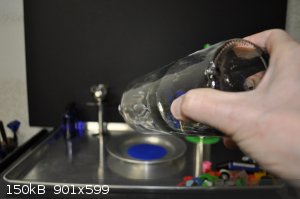 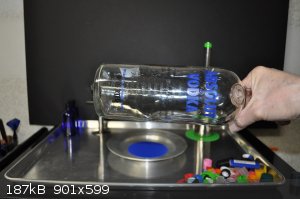 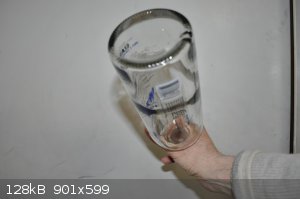
[Edited on 21-12-2019 by Morgan]
|
|
|
Abromination
Hazard to Others
  
Posts: 432
Registered: 10-7-2018
Location: Alaska
Member Is Offline
Mood: 1,4 tar
|
|
Quote: Originally posted by Sulaiman  | Notice that the brand is 'pyrex' which is toughened soda-lime glass,
'Pyrex' or 'PYREX' is borosilicate.
Whether toughened or borosilicate, a hotplate only touches the glass in a few places so thermal stress is unavoidable.
A metal pan with a thin layer of sand or salt evens out the heating. |
Good to know, I knew it was different then lab pyrex by brand but wasn’t sure whether or not it was the same material.
List of materials made by ScienceMadness.org users:
https://docs.google.com/spreadsheets/d/1nmJ8uq-h4IkXPxD5svnT...
--------------------------------
Elements Collected: H, Li, B, C, N, O, Mg, Al, Si, P, S, Fe, Ni, Cu, Zn, Ag, I, Au, Pb, Bi, Am
Last Acquired: B
Next: Na
-------------- |
|
|
S.C. Wack
bibliomaster
    
Posts: 2419
Registered: 7-5-2004
Location: Cornworld, Central USA
Member Is Offline
Mood: Enhanced
|
|
The Pyrex brand is meaningless as it is only a name sold to the highest bidder...just like GE products, complete with the old GE logo, have nothing to
do with General Electric or their old products, or the USA for that matter.
Quote: Originally posted by Morgan  | | Glass is weird stuff. Something like this ordinary Absolut bottle suddenly blasted with heat didn't crack. |
IME heating is not the same as cooling. Which brings us to:
What does this mean? Does it mean you are heating it AND putting water in it? Because this makes no sense since a steel bowl would be the choice
wouldn't it.
If anyone wants to see the effects of thermal stress on thick glass, heating and cooling at the same time will do it.
Ever notice how glass coffee pots that get banged around all the time and should therefore be made to be particularly sturdy are in fact made of
rather thin glass? (apparently the Chinese have not yet got into that arena) It's not because they're trying to save money on SiO2.
|
|
|
Abromination
Hazard to Others
  
Posts: 432
Registered: 10-7-2018
Location: Alaska
Member Is Offline
Mood: 1,4 tar
|
|
Quote: Originally posted by S.C. Wack  | The Pyrex brand is meaningless as it is only a name sold to the highest bidder...just like GE products, complete with the old GE logo, have nothing to
do with General Electric or their old products, or the USA for that matter.
Quote: Originally posted by Morgan  | | Glass is weird stuff. Something like this ordinary Absolut bottle suddenly blasted with heat didn't crack. |
IME heating is not the same as cooling. Which brings us to:
What does this mean? Does it mean you are heating it AND putting water in it? Because this makes no sense since a steel bowl would be the choice
wouldn't it.
If anyone wants to see the effects of thermal stress on thick glass, heating and cooling at the same time will do it.
Ever notice how glass coffee pots that get banged around all the time and should therefore be made to be particularly sturdy are in fact made of
rather thin glass? (apparently the Chinese have not yet got into that arena) It's not because they're trying to save money on SiO2.
|
Hot water bath, and I avoid putting metal on the ceramic top. The hot plate I use advises highly against it. Again I am talking sub boiling
temperatures. It was honestly just something I saw in the store in a moderate quantity for a cheap price, they looked excellent for crystalizing
dishes.
List of materials made by ScienceMadness.org users:
https://docs.google.com/spreadsheets/d/1nmJ8uq-h4IkXPxD5svnT...
--------------------------------
Elements Collected: H, Li, B, C, N, O, Mg, Al, Si, P, S, Fe, Ni, Cu, Zn, Ag, I, Au, Pb, Bi, Am
Last Acquired: B
Next: Na
-------------- |
|
|
S.C. Wack
bibliomaster
    
Posts: 2419
Registered: 7-5-2004
Location: Cornworld, Central USA
Member Is Offline
Mood: Enhanced
|
|
To avoid thermal shock! (because glass is insulating) Says a manual...another manual says not to use large or thick glass containers. If you turn it
up high enough with thick glass full of water, problems are possible.
|
|
|
Abromination
Hazard to Others
  
Posts: 432
Registered: 10-7-2018
Location: Alaska
Member Is Offline
Mood: 1,4 tar
|
|
Quote: Originally posted by S.C. Wack  | | To avoid thermal shock! (because glass is insulating) Says a manual...another manual says not to use large or thick glass containers. If you turn it
up high enough with thick glass full of water, problems are possible. |
Couldn’t ldnt have said that better, I will look out for that. Just wanted to check.
List of materials made by ScienceMadness.org users:
https://docs.google.com/spreadsheets/d/1nmJ8uq-h4IkXPxD5svnT...
--------------------------------
Elements Collected: H, Li, B, C, N, O, Mg, Al, Si, P, S, Fe, Ni, Cu, Zn, Ag, I, Au, Pb, Bi, Am
Last Acquired: B
Next: Na
-------------- |
|
|
monolithic
Hazard to Others
  
Posts: 435
Registered: 5-3-2018
Member Is Offline
Mood: No Mood
|
|
I think I've used those exact style Pyrex bowls on my ceramic hot plate to run hot oil baths up to 170 C without issue.
|
|
|
draculic acid69
International Hazard
    
Posts: 1371
Registered: 2-8-2018
Member Is Offline
|
|
U take the ss wire rack out of your oven and sit that on the hotplate and sit the pyrex on top theres practically no chance of cracking it this
way.there not borosilicate just toughened soda glass.u can get Boro ones but they're very specifically labelled as borosilicate glass and priced
accordingly.
|
|
|
Morgan
International Hazard
    
Posts: 1660
Registered: 28-12-2010
Member Is Offline
Mood: No Mood
|
|
In a way the Absolut bottle is a good example of "if anyone wants to see the effects of thermal stress on thick glass, heating and cooling at the same
time will do it. If you turn it up high enough with thick glass full of water, problems are possible."
At the bottom of the bottle a pool of methanol is cooling the walls, boiling at 64.7 C and indeed jam jar jet failures most often originate or crack
right at or near the level of methanol in the vessel, sometimes in a somewhat neat line where the two temperature gradients meet. It is sometimes
suggested to put the methanol in a separate dish at the bottom to lessen the stress.
This sort of happening ...
https://www.youtube.com/watch?v=7ajpI91UxyI
https://youtu.be/KIE8m5dzFO8?t=128
There are those videos of tests on "Pyrex" bakeware filled with sand where they are taken out of a hot oven and placed on a wet surface only to
shatter. There was one old and true pyrex dish that withstood the test at 500 F while the basic test was at 450 if I recall correctly.
As an aside, a sad ending to the Absolut.
https://www.youtube.com/watch?v=ImmewZnfjtE
[Edited on 22-12-2019 by Morgan]
|
|
|
SWIM
National Hazard
   
Posts: 970
Registered: 3-9-2017
Member Is Offline
|
|
The thickness really is a vital factor even with the best of borosilicate.
Pyrex makes their viscous reaction kettles out of very thick glass, and it's absolutely not supposed to be heated in any way but a mantle (low watt
density means less tendency to crack).
The newer ones have warnings printed on them which, as an owner of old, unlabeled reaction vessels, surprised the hell out of me. I never cracked one
(From Heat as opposed to from stupid) , but I seldom used them at high temperatures and always used water or oil baths.
I'm pretty sure these things are made from the same quality boro as their other labware and that the thickness is where the danger lies.
A side note: the spate of shattering baking pans was probably made worse in part by the fact that at the same time PYREX started being Pyrex (non-boro
baking dishes) the kitchen remodeling industry in the USA was getting all worked up about stone countertops.
Tiles were replaced with thick slabs of marble or granite in kitchens across the land, and I suspect these countertops make better heat sinks than
tile surfaces and therefore put even more stress on the marginally effective tempered bakeware.
Certainly the granite slab I use to work doughs and pastas works great as a heat sink for cooling off pies straight from the oven.
Another side note: Pork Pies Effing rule! Don't know how you Brits can be so down on your own cuisine when you came up with something like that. Who
needs dainty sauces when you''ve got pork pie jelly? You're the world champs at finding ways to make pastry with meat. Only the Persians and Chinese
come close. Be proud.
|
|
|
Morgan
International Hazard
    
Posts: 1660
Registered: 28-12-2010
Member Is Offline
Mood: No Mood
|
|
I remember buying various large Kimax erlenmeyer flasks from a retiring chemist answering an ad in the paper. I remarked to him about them being a
thin glass and he said they're less likely to crack. It was close to Mark Twain's house in Hartford, Ct.
Anyway I wonder if there are any unique borosilicate vessels or containers that are made thinner than say 2 mm?
With quartz you can heat thin sheets red hot and dip them in water without cracking. I tried to crack some 3 mm quartz tubing with my torch but
failed. It's uncanny because you are so use to glass being fragile under rapid temperature changes.
https://youtu.be/IHnM3fIhntA?t=67
[Edited on 22-12-2019 by Morgan]
|
|
|
S.C. Wack
bibliomaster
    
Posts: 2419
Registered: 7-5-2004
Location: Cornworld, Central USA
Member Is Offline
Mood: Enhanced
|
|
Quote: Originally posted by Morgan  | | Anyway I wonder if there are any unique borosilicate vessels or containers that are made thinner than say 2 mm? |
Mr Coffee pots appear to be quite thin but I don't have the caliper to measure this. (home coffeeware of various manufacturers seems to be
borosilicate)
|
|
|
Morgan
International Hazard
    
Posts: 1660
Registered: 28-12-2010
Member Is Offline
Mood: No Mood
|
|
This was an informative clip on borosilicate glass, the last half had more of the good to know stuff but the whole video was worth watching.
The Story of Borosilicate Glass: Why Pyrex was Special
https://www.youtube.com/watch?v=dwKzoQdj1v8
The coffee pots are indeed less than 2 mm, using a micrometer to get around the top rim which is thicker. I measured some regions at around 1.7 mm and
there was one spot even lower and some higher. And consider I couldn't clamp onto a perfectly flat surface.
I wonder though if they make any borosilicate shapes ultra thin for some cryogenic experiments or something unique where a very thin glass might be
needed? I could see mm tubing of course, things like that, but something flask or bottle shaped and lightweight.
[Edited on 23-12-2019 by Morgan]
|
|
|
Morgan
International Hazard
    
Posts: 1660
Registered: 28-12-2010
Member Is Offline
Mood: No Mood
|
|
Here's another product that might be repurposed for some lab application or obscure usefulness. The glass is uniformly thin and has but a small hole
in the top center.
https://www.fireflyfuel.com/oil-candles/firefly-pillar-oil-c...
If you scroll down there are 3 sizes in the oil candle pillar design.
https://www.fireflyfuel.com/category/oil-candles
Firefly Fuel | Transcend Glass Oil Lamp
https://www.youtube.com/watch?v=zQUhR1ifoAU&feature=yout...
Firefly Pillar Candle Burning Firefly Paraffin Lamp Oil
https://www.youtube.com/watch?v=pNV2XKvXRnY
Oil Lamp Wick - Trimming
https://www.youtube.com/watch?v=o16F7yE8Muo
[Edited on 27-12-2019 by Morgan]
|
|
|